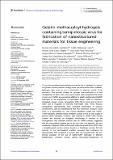Por favor, use este identificador para citar o enlazar a este item:
http://hdl.handle.net/10261/303717COMPARTIR / EXPORTAR:
 SHARE SHARE
 CORE
BASE CORE
BASE
|
|
| Visualizar otros formatos: MARC | Dublin Core | RDF | ORE | MODS | METS | DIDL | DATACITE | |

| Título: | Gelatin-methacryloyl hydrogels containing turnip mosaic virus for fabrication of nanostructured materials for tissue engineering |
Autor: | González-Gamboa, Ivonne; Velázquez-Lam, Edith; Lobo-Zegers, Matías José; Frías, A.; Tavares-Negrete, Jorge Alfonso; Monroy-Borrego, Andrea; Menchaca-Arrendondo, Jorge Luis; Williams, Laura; Lunello, Pablo; Ponz Ascaso, Fernando; Álvarez, Mario Moisés; Trujillo-de Santiago, Grissel | Palabras clave: | GelMA TuMV VNP Biofabrication Bioprinting Nanomesh Nanoscaffold Tissue engineering |
Fecha de publicación: | 2-sep-2022 | Editor: | Frontiers Media | Citación: | Frontiers in Bioengineering and Biotechnology 10: e907601 (2022) | Resumen: | Current tissue engineering techniques frequently rely on hydrogels to support cell growth, as these materials strongly mimic the extracellular matrix. However, hydrogels often need ad hoc customization to generate specific tissue constructs. One popular strategy for hydrogel functionalization is to add nanoparticles to them. Here, we present a plant viral nanoparticle the turnip mosaic virus (TuMV), as a promising additive for gelatin methacryloyl (GelMA) hydrogels for the engineering of mammalian tissues. TuMV is a flexuous, elongated, tubular protein nanoparticle (700-750 nm long and 12-15 nm wide) and is incapable of infecting mammalian cells. These flexuous nanoparticles spontaneously form entangled nanomeshes in aqueous environments, and we hypothesized that this nanomesh structure could serve as a nanoscaffold for cells. Human fibroblasts loaded into GelMA-TuMV hydrogels exhibited similar metabolic activity to that of cells loaded in pristine GelMA hydrogels. However, cells cultured in GelMA-TuMV formed clusters and assumed an elongated morphology in contrast to the homogeneous and confluent cultures seen on GelMA surfaces, suggesting that the nanoscaffold material per se did not favor cell adhesion. We also covalently conjugated TuMV particles with epidermal growth factor (EGF) using a straightforward reaction scheme based on a Staudinger reaction. BJ cells cultured on the functionalized scaffolds increased their confluency by approximately 30% compared to growth with unconjugated EGF. We also provide examples of the use of GelMA-TuMV hydrogels in different biofabrication scenarios, include casting, flow-based-manufacture of filaments, and bioprinting. We envision TuMV as a versatile nanobiomaterial that can be useful for tissue engineering. | Descripción: | 16 Pág. | Versión del editor: | https://doi.org/10.3389/fbioe.2022.907601 | URI: | http://hdl.handle.net/10261/303717 | DOI: | 10.3389/fbioe.2022.907601 | ISSN: | 2296-4185 |
| Aparece en las colecciones: | (INIA) Artículos |
Ficheros en este ítem:
| Fichero | Descripción | Tamaño | Formato | |
|---|---|---|---|---|
| Gelatin_methacryloyl_hydrogels_containing.pdf | artículo | 2,8 MB | Adobe PDF |  Visualizar/Abrir |
CORE Recommender
PubMed Central
Citations
2
checked on 16-abr-2024
SCOPUSTM
Citations
7
checked on 14-may-2024
WEB OF SCIENCETM
Citations
3
checked on 26-feb-2024
Page view(s)
49
checked on 15-may-2024
Download(s)
24
checked on 15-may-2024

